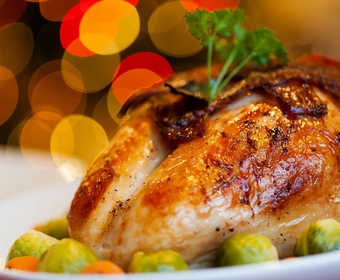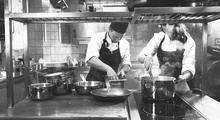What are the dos and don'ts when serving up a turkey for christmas? Ten inspiring (and not all that complicated) tips straight from the pros:
1. Pay a little more
The same goes for your christmas turkey as for any other produce in your kitchen: The raw material matters. A lot. If you want quality you have to pay for it. Consult your butcher. But also remember (which your butcher will probably tell you): Frozen turkeys are frozen immediately after butchering, thaw them the right way (slowly!) and you can get a very decent result.
2. Don't stuff the stuffing
The reason why you have eaten so many dry turkeys is that with this technique the bird is cooked through long before that cavity full of stuffing is. We suggest you cook the "stuffing" on the side. Flavor the inside of the turkey with – for example – salt, pepper, lemon, garlic, onions and herbs. Cook the stuffing to beautiful perfection in a pan.
3. Open up
You're cooking the stuffing on the side, so you can let the heat cook the bird from all sides by leaving the cavity open. You will get less of that "pink meat syndrome" next to the bones.
4. Vegetables too
Give the veggies some time in the heat, on the bottom of the oven tray with the bird, the french way. It's a win-win situation: The vegetables will soak upp flavors while at the same time making the gravy even better...
5. Brining is a good idea
A night in brine will give you a juicy and flavorful turkey. A suitable brining solution contains 10% salt (1 dl in 1 liter of water). replacing some of the salt with sugar and adding aromatic spices is optional.
6. First dried – then greased
When you start, the skin of the turkey should be as dry as possible. Rub it all over with butter/oil – and make sure to get lots of it under the skin, too.
7. Baste less
If you have done a thorough job of covering the bird in fat, you can do less basting. (The problem with basting is that every time you open that oven door the heat escapes and the cooking process has to start over...)
8. Use a good thermometer.
If you don't have a sensitive, fast digital thermometer, go out and get one. It will work wonders for your meat-cooking skills. Measure the temperature in the thickest part of the turkey. Put the probe in the around the thigh and avoid the bone. After taking the bird from the oven the temperature will keep rising. According to the pros: The rise will be 4% of the oven temperature (i e 8°C after cooking in a 200°C oven).
9. Breasts overcook before legs
The meat on the turkey breast starts turning dry at 65°C/150°F, the legs can take a lot more, up to 80°C/175°F (which is lucky, since the legs are more exposed to the heat).
10. Time to rest
Let your turkey rest for at least 15 minutes before carving. Don't cover it entirely in foil or it will overcook. And the steam will soften up the crispy skin.
Read more about turkey here: Professional Secrets Academy: Turkey






